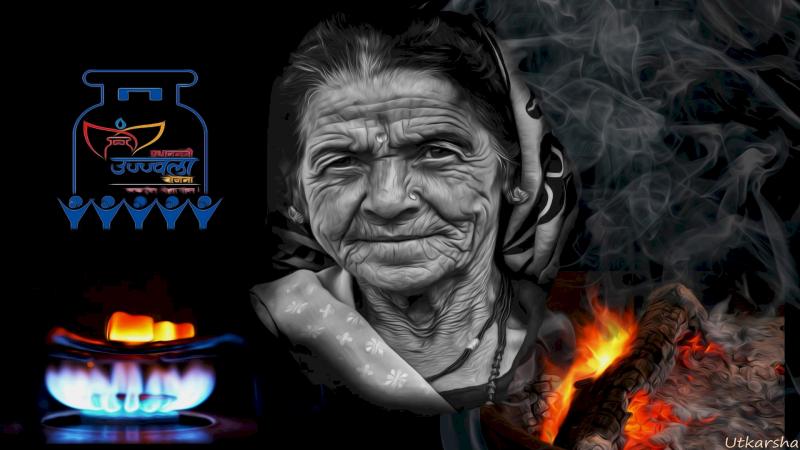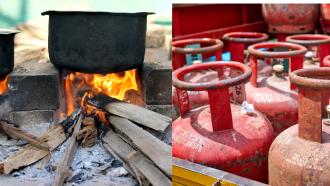
As a girl who often visited my grandparent’s village in the foothills of the Shivaliks, I recollect the morning trips we would take to gather twigs, dry grass, cow dung cakes and wood, to be used as fuel for the chulha or the stove. During most of the day, the women of the house sat cooking and coughing their lungs out in a murky stifling kitchen. Statistics show that such smoke-filled kitchens took the lives of 1.2 lakh people in 2015.
The Pradhan Mantri Ujjwala Yojna (PMUY), introduced in 2016, aimed to turn around this situation. It was intended to assist poor households in the adoption of cleaner cooking fuels such as Liquified Petroleum Gas (LPG), and thus liberating women from the smoke-filled kitchens. In preparation for this scheme, the government had first requested people to voluntarily give up their LPG subsidy, which was provided to subsidise the cylinder prices for regular LPG consumers. Between 2015 and 2018, 4% of registered LPG users gave up their allowance to give funds for the Ujjwala program.
The Ujjwala scheme entailed that the government will pay half the money required for the security deposit, pressure regulator, Suraksha hose and demonstration charges for the first LPG connection. The beneficiary will pay the other half for buying a cooking stove and an LPG cylinder. To help families who could not afford the money, this second half of the payment could be loaned from oil marketing companies. The subsidy amount would be used as an EMI for the repayment of this loan. The LPG connections were distributed only to the female head of the family.
The scheme proved to be very attractive and has reached 80 million low-income families across the country. However, can we call it successful merely based on the number of people it has covered? A study, published by researchers from Canada, Austria, and the USA, compared the enrolment for the Ujjwala program and the trend of LPG consumption in rural Karnataka and found that although the scheme was successful in delivering its promises, it's success has been a topic of national debate.
“Once the entire program became overtly political, the goalposts changed. The supporters, deliberately or otherwise, conflated LPG connection with smokeless kitchen, while the opponents pointed to data/case study of Ujjwala beneficiaries using firewood as evidence of the scheme failing its mission,” explains Dr Abhishek Kar. He is a researcher at the University of British Columbia and is the lead author of the paper. The Ujjwala scheme delivered it's promise of providing LPG access to poor women, and was very successful in those terms. “Ujjwala was necessary but not sufficient to result in smokeless kitchens,”clarifies Dr. Kar
The study analysed a national dataset containing state-wise aggregated data for LPG purchase by 30 million PMUY beneficiaries. Local consumption trend was measured used sales data from January 2016 to December 2018 from LPG distributors in 120 villages of Koppal district in Karnataka. This dataset covered 25000 PMUY beneficiaries and general consumers, who bought LPG connection at the market rate.
Although the analysed data represents a single district in Karnataka where the scheme was implemented in July 2017, the study presents a new approach towards testing the Ujjwala scheme. It relies on data on the sale of LPG cylinders to estimate how much fuel is used within a given period of time. This data is a goldmine for information that is unbiased as it does not rely on self-answered surveys.
The study found that introducing the Ujjwala scheme saw an increase in the number of enrollments for LPG connections, along with a decrease in the number of new general consumers. There might be two factors contributing towards this trend. Either, certain general consumers who were also eligible for the PMUY scheme took undue advantage by enrolling with the scheme rather than buying a general connection; or certain general consumers chose to wait before buying an LPG connection until they were included in the PMUY slab. These factors might have additively or individually disturbed the statistics for the Ujjwala scheme.
The sales data used for this study is a representation of the amount of LPG used within the rural households in Karnataka. While many people can enrol for the Ujjwala scheme, LPG refill sale shows the extent of LPG utilisation. Under the Ujjwala scheme, enrolment did not translate to actual LPG use. General LPG consumers had almost two times more LPG refills than Ujjwala beneficiaries. Even among the general users, the total LPG consumption was low enough to suggest that LPG was being used as a secondary fuel.
“Increasing LPG use in poor households, who have easy access to free firewood without massive subsidies, is a challenging task. Apart from massive subsidies, like those in Ecuador, there are no easy solutions to overcome the problem of LPG adopters continuing to depend on firewood,” reasons Dr Kar, talking about the findings.
So, what stops people from using LPG as a primary fuel source? The authors tracked LPG sales for five years among rural consumers and found that more experience with handling the LPG stove and cylinder did not contribute to more LPG use. Other factors such as LPG price, subsidy amount, LPG distributors, and climatic conditions were stronger determinants of LPG consumption within the household. This hypothesis is supported by the sales data, which was higher for specific LPG distributors and fluctuated as the LPG price changed. Besides, cropping and harvesting months saw a rise in LPG sales, whereas they plummeted in the dry part of the year. The researchers attribute this trend to a combination of varying workload, non-availability of dry biomass and seasonal variability of agricultural income of the family. They suggest that seasonal vouchers or other incentives must be provided to all consumers to increase LPG sales within the rural community.
The study demonstrates that the Ujjwala scheme has been partly successful and has the potential to rid the country of smoky kitchens. However, there is no silver bullet to solving this issue.
“I have been working the space of cooking energy access since 2007. In the last 12 years, I have learned that we do not know enough to confidently prescribe that doing X, Y & Z will solve the problem,” says Dr Kar, recounting his experience.
However, in the case of schemes like Ujjwala, there are unique challenges.
“It is a triple whammy. Firstly, people with low income are asked to make new expenses. Secondly, in rural areas, free alternative fuels like wood, crop residue, and cattle dung cake are available. Thirdly, in a developing country like India, we have limited ability to subsidise LPG,” details Dr Kar. So, what exactly do we need to make schemes like this work better? “We need to invest in pilot experiments, which are carefully designed and monitored, to learn more about how to solve the problem. We need to learn more and test more, far more than what is currently being done,” he signs off.
This article has been run past the researchers, whose work is covered, to ensure accuracy.






